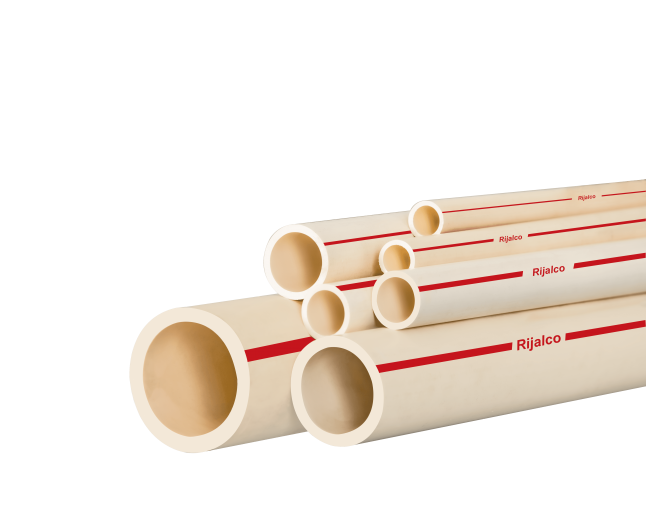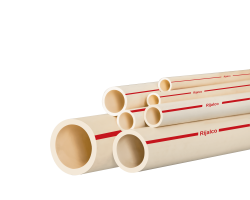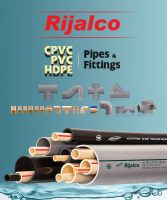Why do people choose Rijalco’s PVC and CPVC?
Why PVC Pipes?
We always look for the best pipe for underground water supply no matter whether it is for our
homes or offices. Drinking water remains one of the most fundamental resources in the world.
Therefore, the quality of the drinking water matters. The World Health Organization (WHO)
states that globally at least 2 billion people come into contact with feces contaminated drinking
water. It gave birth to the drinking water guidelines for drinking water quality (GDWQ). The WHO
also called for more research on microplastic and its contamination in drinking water.
Many underground water pipes float in the market. However, most agree that PVC pipes are the
best underground water line pipe. Most standard tests approve and promote CPVC pipes for
water supply now more than ever.
What type of pipe is used for underground water lines?
There are various plasticized underground water pipes in the market used for various purposes
of modern construction. Such pipes typically undergo the polymerization of vinyl chloride. Thus,
the name PVC (Polyvinyl Chlorine) came into existence. PVC has been relatively the best
choice for both residential and commercial purposes of water supply. The PVC pipes stand out
because of numerous reasons starting from strength and durability to cost-effectiveness.
However, there are other pipes also that have their functionality. It is important to see each
pipe’s utility to select one for its usage. While some may be good for water supply, others might
be good for sewage systems.
Types of PVC Underground water pipes
Polymerized pipes are the most widely used pipes in the market. Currently, almost every
household in Nepal uses some form of PVC pipe for transportation of both normal water and
drinking water. The types of PVC pipes depend upon their chemical formation. This ultimately
also differentiates their utility and use.
The popular PVC pipes can be categorized as below:
PVC-U water pipe
This is the most common PVC water pipe found in daily use. These pipes are Unplasticized and
therefore very rigid in form. However, their durability makes them useful for all kinds of
transportation of water as pipes and fittings. Moreover, the PVC-U pipes are used for sewage
and industrial purposes as well. These pipes are the best choice for any transportation of
drinking water as they are more than safe.
PVC-U pipes also remain unaffected by strong UV rays thus making it a wonderful option for
underground water supply. In fact, its durability and strength are so high that it can be used for
over a century. Due to their chemical formation, these pipes are recyclable. Therefore, PVC-U
pipes are good for both us and the environment.
Rijalco has PVC pipes that retain all the good properties of PVC-Us including high durability and
cost-effectiveness.
CPVC water pipe
CPVC water pipes or Chlorinated Polyvinyl Chlorine pipes are the reformed versions of the
already advantageous PVC pipes. CPVC retains all the good qualities of PVC pipes including
high durability, safe for drinking water transportation, and does not affect UV rays. Additionally,
CPVC water pipes withstand high and low temperatures. While PVC pipes can only withstand
temperatures below 140 Fahrenheit, CPVC has a larger margin in that arena.
Therefore, CPVC is the best pipe for underground drinking water supply. These modified PVC
pipes have been used widely over the last decade. Their durability is a testament to their
efficiency and utility. CPVC is also 100% recyclable making it the best water pipe in Nepal.
Rijalco CPVC pipes have long been used for proper transportation of drinking water that is safe.
The Rijalco pipes go through rigorous testing to assure quality. Thus, all of Rijalco’s pipes have
been above the standard for a long time.
PVC-O water pipe
PVC-O is a molecularly altered version of PVC-U which turns the unplasticized PVCs into a
layer structure. In a sense, PVC-Os are highly resistant in addition to the already sturdiness of
PVC-Us. Thus, these pipes retain tenacity and fatigue resistance. It means that the PVC-O
works best for highly pressurized water sources. These pipes are used as underground water
pipes with the best ability to sustain pressure. In areas requiring irrigation, PVC-O is used most
of the time. Nevertheless, they have been long used for sewer pumping as well. Moreover,
much like PVC-U and CPVC pipes, PVC-Os pipes and fittings are recyclable.
Modified PVC
Modified PVC falls under the thermoplastic family which has been composed by adding
modifying agents to PVCs. These agents strengthen the PVC pipes, making them even tougher
and highly resistant to cracks. The modifying agents even make these pipes thinner, more
efficient, and resistant to scratches. Modified PVCs, mostly PVC-HI have been long used
against impact blows. These types of modified PVCs are found in the Netherlands where they
transport hydrogen gas. As clean and green energy rises in Europe, PVC-HIs have been
consistently rising in popularity to transport hydrogen gas. These have potential in the Nepalese
market to give rise to alternative fuel sources.
Advantages of Using PVC and CPVC water pipes
From the types, it is undeniable that PVC and CPVC are the most versatile water pipes for any
modern usage. Both pipes have similar properties. CPVC pipes to most are the better choice as
well because of some upgraded utility. Some of the advantages of using PVC and CPVC water
pipes are:
Safe
Many households use PVC and CPVC for drinking water. These pipes are one of the safest
options for drinking water transportation. The inertness provides a practical impossibility of
corrosion. Such high resistance to corrosion, as well as penetration, makes PVC pipes free from
biofilm contamination. Drinking water remains safe, without any breeding of harmful bacteria.
PVC pipes remain free of any leads as well. In addition to safety, these pipes provide pure
drinking water without harmful chemicals. These pipes contain a highly functional barrier to
molecular transmission inside. Thus, PVC and CPVC are the best pipes for public drinking water
supply systems as well. Rijalco has both pipes that have passed the standardized tests set by
the Nepal Government.
Durable
PVC and CPVC pipes are some of the most durable underground water pipes on the market.
The durability comes from its polymerized reaction. Most PVCs last up to 100 years! It saves a
lot of trouble in fitting water systems or maintenance. PVC piping systems in underground lines
also show a much lower failure rate than other pipe systems. Thus, PVC can last up to our life
with its lightness and flexibility. It saves time and money consequently.
Cost-efficient
PVC and CPVC pipes are both multi-purpose and multi-utility pipes. They can be used for
various purposes. But most consumers worry about their costs. Imagine if a person had a
system that could last up to a lifetime. It would cut off any maintenance or extra costs. PVCs are
much cheaper than copper pipes and have the same utility benefits. PVCs also tend to be
easier to handle and install, thus even reducing installation costs considerably. Rijalco PVC
pipes also flaunt these qualities all the while being reasonably priced than any other PVC pipes
in the market.
Sustainable
While talking about the sustainability of products, we must acknowledge the sustainability of the
planet as well. PVC pipes are free from harmful leads that can poison precious water sources.
In fact, its inertness also prevents sewage seepage in soil. As underground water pipes, PVC
remains the most sustainable as it is a low-carbon plastic. Very little energy is required to
produce and transport these pipes. Thus, they are the most sustainable underground water
pipes built yet.
Recyclable
PVC and CPVC pipes are 100% recyclable. They are low maintenance. The pipes are
sometimes recycled to make new PVC and CPVC pipes. Some three-layer PVC pipes contain
core layers that have been recycled and then reused. This reduces both a strain on the wallet
and a stain on the planet.
Disadvantages of Using PVC water pipes
The only disadvantage of using PVC water pipes is that they can only withstand about 140
Fahrenheit in temperature. Thus, extreme heat can bend and damage these pipes. If PVCs are
exposed above ground, they are susceptible to damage just like any other pipes. Ultraviolet light
can also damage PVC pipes. For hot water transportation or water systems in a hot area, CPVC
is considered the best alternative. As copper pipes and fittings are very expensive, CPVC
remains the best pipes for underground water supply in hot areas.
Frequently Asked Questions
Can CPVC be used for underground water supply?
Yes, CPVC is the best pipe for underground water supply. They can withstand extreme
temperatures, are highly durable and cost-effective as well.
Are PVC pipes toxic?
While PVC contains polymerized chlorine, unless subjected to external high-temperature
heating, PVCs are not toxic.
What is the best pipe for underground water supply in Nepal?
Both PVC and CPVC are the best pipes for underground water supply in Nepal. Rijalco caters to
both categories of underground water line pipes.






